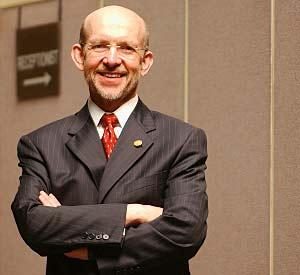By Sam H. Stone ’14
To the average traveler, a flight out of Ontario International Airport is a dream come true. Located in the city of Ontario, it sits at the border between Los Angeles County and San Bernardino County, and offers easy access to the LA metropolitan area as well as the Inland Empire. While a trip to LAX from the Inland Empire can take upwards of an hour, traffic going to Ontario Airport is rarely an issue. Travel through the airport is speedy too. Even on the busiest travel days of the year, lines at Ontario Airport are virtually non-existent. Flights mostly run on time, and the airport is small, well-designed, and easily navigable.
While the short lines at Ontario Airport may be a blessing to passengers, to airport officials and insiders, they are just the latest symptom of a dying airport. Officials in Ontario, Los Angeles, and the Inland Empire have all expressed concern about Ontario Airport’s future, and called attention specifically to the airport’s unique operational structure. Ontario International Airport is actually owned and operated by the city of Los Angeles. Los Angeles World Airports (LAWA), a department of the Los Angeles city government, runs both LAX and Ontario Airport, as well as Van Nuys Airport in San Fernando. Although LAWA successfully managed Ontario Airport in the past, the airport’s recent decline has caused many to question this operational model.
The statistics for Ontario Airport certainly point to trouble. In 2009, Ontario Airport’s annual passenger volume fell to five million, a decline of 28 percent in a decade. Average daily departures on Southwest, Ontario Airport’s highest volume airline, declined from 58.4 in 2001 to 39.7 in 2010. JetBlue and ExpressJet, once promising new additions, have more recently abandoned the airport entirely. Passenger traffic at Ontario Airport has fallen sharply, domestic flights have been slashed, and airlines have left in droves. While other airports around the country and in Southern California have been on a road to a post-recession recovery, Ontario Airport has remained stagnant.
Ontario Airport’s decline has serious consequences for the entire region. Recent estimates by the city of Ontario suggest that the Inland Empire lost upwards of $400 million in business and revenue, as well as more than 8,000 jobs from 2007 to 2009 directly because of Ontario Airport’s decline.
Ontario Airport wasn’t always on such a tumultuous path. Thanks to low costs and robust support from numerous airlines, Ontario Airport enjoyed significant increases in annual passenger volume throughout the 1980s and 1990s. Annual passenger volume increased from approximately two million in 1980 to seven million in 2007. In 2000, JetBlue chose Ontario Airport as its first west coast destination.
What went wrong in Ontario? The answer is not difficult to identify—for airlines, it is an exorbitantly expensive place to operate. Airports use a measurement called Cost per Enplaned Passenger (CPE) to compare costs. In United States airports, the median CPE is $6.76. In contrast, Ontario Airport’s estimated CPE was $14.50 for 2010, more than 214 percent above the median. This is higher than every other major regional airport. Similar sized airports in the southern California region, such as Long Beach ($5.34) and Palm Springs ($4.07), are less expensive. Even LAX, despite being a much larger airport, has a CPE of $11. With such prohibitively high costs, Ontario Airport is unable to offer competitive prices, and consequently, airlines have low profit margins at Ontario Airport and little incentive to operate there.

What is behind these enormous costs? According to Greg Devereaux, Chief Administrative Officer of San Bernardino County, there are three primary reasons for the high cost of operation at Ontario Airport: a costly and unnecessary administrative fee imposed by LAWA, overstaffing, and overcompensation of airport employees.
LAWA charges Ontario Airport a 15 percent fee as overhead for “administrative fees.” Some believe that this fee is superfluous. Devereaux estimates that once the administrative fee is taken into account, the airport is effectively paying staffing costs “triple the size of other [comparable] airports.” According to a report commissioned by the City of Ontario in 2010, Ontario International Airport – A Recovery Plan, “this administrative charge alone adds $3.68 per enplanement to Ontario Airport’s costs—which is more than Orange County, San Diego, or Burbank paid in total compensation and benefits per enplanement in FY2008.”
The second issue is overstaffing. Until very recently, Ontario Airport had more than twice the number of employees as most comparably sized airports. With 302 budgeted employees, and 85 additional LAWA employees (compensated via the administrative fee), Ontario Airport employs a significantly larger staff than John Wayne (175) and Long Beach (124), despite comparable traffic. This problem is nothing new. As Deveraux notes, “Even at the point where [Ontario Airport] had 7 million passengers, it was clearly overstaffed.” While other airports were able to cut down on staff following a decline in business, local labor unions have been a major obstacle to initiating staffing changes at the airport.
The final source of Ontario Airport’s high cost is perhaps the most surprising. Not only does Ontario Airport appear to have significantly more employees than necessary, it also pays them at an inflated rate. Ontario Airport, with a compensation budget of $30.9 million for 302 budgeted employees, pays an average of $102,400 per employee. According to Devereaux, this high level of compensation occurs because employees of Ontario Airport are paid according to the Los Angeles living wage ordinance and payroll structure, rather than that of Ontario. Ontario Airport employees are compensated as if they lived in Los Angeles even though most live in the Inland Empire, where the cost of housing alone is 34 percent lower, according to CNN/ Money. Thus, overstaffing compounded by overcompensation of airport employees has contributed to the high cost of operations at Ontario Airport.
In response to mounting criticism, LAWA recently cut Ontario Airport staff by 30 percent through early retirements and transfers to other LAWA-owned airports. Yet even now, LAWA Executive Director Gina Marie Lindsey acknowledged in an interview with the Daily Breeze that the airport has “not been able to keep pace with the reduction in traffic and revenues.” Ontario Airport remains an overstaffed and exceptionally expensive airport, even after these reductions.
The alleged inefficiencies caused by the governance structure at Ontario Airport are not the only points of concern for local officials. Devereaux and members of the Ontario city council have repeatedly expressed their concern that the city of Los Angeles is not doing enough to help save Ontario Airport. Devereaux points out that LAWA “hasn’t been meeting out in Ontario” for several years and appears to be “focusing on building in LA,” rather than Ontario Airport. These facts, says Devereaux, combined with LAWA’s decision to slash Ontario Airport’s marketing budget by 85 percent in 2008, appear to indicate of a clear “lack of focus and interest [from LAWA] even as the number of passengers [at Ontario Airport] was declining.”
Executive Director Lindsey responded to these concerns in a March 1, 2011 letter acknowledging the difficulty of giving Ontario Airport complete focus, while denying that LAWA has been inattentive. “We do agree that given LAWA’s portfolio of responsibilities, it is impossible for our senior management team to devote its full attention to [Ontario airport], just as it is impossible for us to devote our attention exclusively to Los Angeles International Airport or our other two airports.”
While diagnosing the problem of high costs facing Ontario Airport is fairly simple, prescribing a solution is much more difficult, and there remains a significant divide over what action should be taken.
Officials in the City of Ontario and in San Bernardino County argue that the best course of action is to have LAWA retain ownership, but to transfer operational control to the City of Ontario. Devereaux firmly believes that costs could be reduced immediately with the transfer of operational authority. “You could get it down to about a $10.50 CPE right away,” he says.
Devereaux isn’t the only advocate for such a change at Ontario Airport. State Senate Minority Leader Bob Dutton (R-Rancho Cucamonga) recently authored a resolution calling for a transfer of control over Ontario Airport from Los Angeles to a local authority. It is co- sponsored by Assembly members Wilmer Amina Carter (D-Rialto), Kevin Jeffries (R-Lake Elsinore), Brian Nestande (R-Palm Desert) and Norma Torres (D-Ontario). The resolution asserts that a local authority, such as the City of Ontario, would be the most capable of turning Ontario Airport around.
Deveraux and others have been involved in ongoing negotiations with the City of Los Angeles to transfer control of the airport; however, Executive Director Lindsey and other LAWA officials have expressed concerns that the City of Ontario, without any experience in airport management, may not be the best group to take over control. As a result, LAWA has recently begun exploring other options for a transfer of authority, including a number of potential private solutions.
Viggo Butler, an expert in airport privatization and the chairman of the aviation subcommittee at the Los Angeles Economic Development Corporation, sees a number of potential solutions involving private contractors working in conjunction with government groups. Ten private firms, including the Carlyle Group and Goldman Sachs Infrastructure Partners, have thus far expressed interest in becoming involved with Ontario Airport.
According to Butler, a private solution for Ontario Airport could take a number of forms. One idea involves Los Angeles retaining ownership, while granting operational authority to a private entity through a long term lease. A public-private partnership, in which a government sponsoring agency (either Ontario or a new authority with Ontario and San Bernardino County) joins with a private investment firm to operate the airport jointly, similar to the model employed at the Burbank airport, may also be possible. A third possibility involves an outright sale of the airport; Los Angeles officials, including City Councilwoman Janice Hahn, have expressed a newfound willingness to put a transfer of ownership on the table.
While there is little precedent for airport privatization in the United States, Butler points to London Heathrow Airport as an example of successful private airports. Further, he notes that Ontario Airport has large capacity for terminal expansion—an asset no other Southern California airport enjoys—and direct access to the Inland Empire. Both give it enormous potential for growth. According to Butler, these factors make control of the airport particularly appealing to private entities.
The potential for long term cost reduction with a transfer of ownership is substantial. A transfer of operational control to the City of Ontario or a private firm could present cost- cutting options currently unavailable to LAWA. Depending on the structure of ownership and control, a new owner may not be bound by the L.A. living wage ordinance in the future. Devereaux believes that with a staff cost reduction and relief from the LAWA administrative fee, Ontario Airport’s CPE could eventually fall to the $5-$7 range. If Ontario Airport succeeds it may be able to convince low cost carriers like Virgin, Jet Blue and Southwest to return or expand service. With more carriers, lower costs, and increased marketing, Ontario Airport may be able to get back on track.
The battle over Ontario Airport’s control and future is enormously important to the Inland Empire and Southern California as a whole. Despite some setbacks and delays, local officials remain optimistic. “We have made a lot of progress and I am hopeful that many of these groups know that it is in the long term interest of Southern California and L.A. to make the airport successful,” said Devereaux. For now, Ontario Airport remains at a crossroads, grounded squarely on the tarmac.


Sorry, comments are closed for this post.